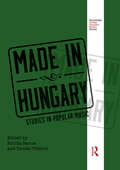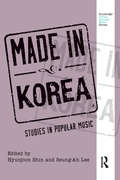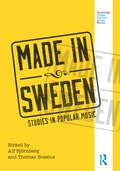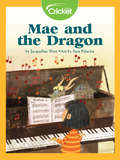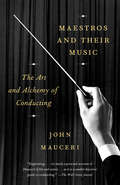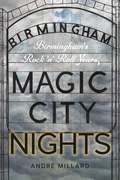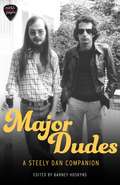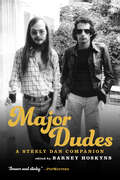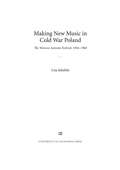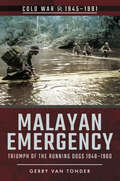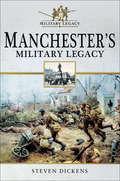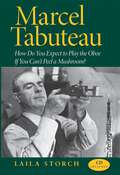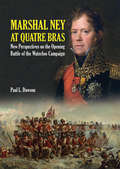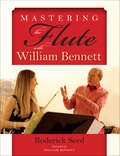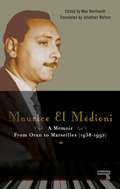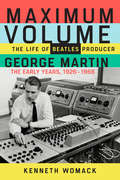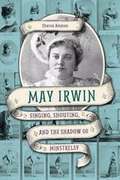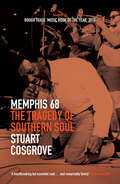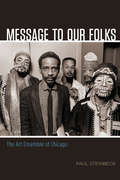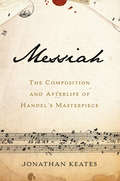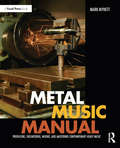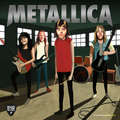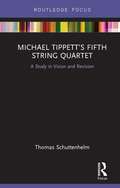- Table View
- List View
Made in Hungary: Studies in Popular Music (Routledge Global Popular Music Series)
by Emília Barna Tamás TófalvyEmília Barna is Assistant Professor at the Budapest University of Technology and Economics. She is a founding member and Chair of IASPM Hungary, editor of Zenei Hálózatok Folyóirat (Music Networks Journal), and Advisory Board Member of IASPM@Journal. Tamás Tófalvy is Assistant Professor at the Budapest University of Technology and Economics. He was the founding Chair and is the current Vice-Chair of IASPM Hungary.
Made in Korea: Studies in Popular Music (Routledge Global Popular Music Series)
by Hyunjoon Shin and Seung-Ah LeeMade in Korea: Studies in Popular Music serves as a comprehensive and thorough introduction to the history, sociology, and musicology of contemporary Korean popular music. Each essay covers the major figures, styles, and social contexts of pop music in Korea, first presenting a general description of the history and background of popular music in Korea, followed by essays, written by leading scholars of Korean music, that are organized into thematic sections: History, Institution, Ideology; Genres and Styles; Artists; and Issues.
Made in Sweden: Studies in Popular Music (Routledge Global Popular Music Series)
by Alf Björnberg and Thomas BossiusMade in Sweden: Studies in Popular Music serves as a comprehensive and rigorous introduction to the history, sociology and musicology of twentieth-century Swedish popular music. The volume consists of essays by leading scholars of Swedish popular music and covers the major figures, styles and social contexts of pop music in Swedish. Although the vast majority of the contributors are Swedish, the essays are expressly written for an international English-speaking audience. No knowledge of Swedish music or culture will be assumed. Each essay provides adequate context so readers understand why the figure or genre under discussion is of lasting significance to Swedish popular music; each section features a brief introduction by the volume editors. The book presents a general description of the history and background of Swedish popular music, followed by essays that are organized into thematic sections: The Historical Development of the Swedish Popular-Music Mainstream; The Swedishness of Swedish Popular-Music Genres; Professionalization and Diversification; and Swedish Artist Personas. Contributors: Jonas BjälesjöAlf BjörnbergThomas BossiusPeter DahlénOlle EdströmKarin L. ErikssonRasmus FleischerSverker Hyltén-CavalliusLars LilliestamUlf LindbergMorten MichelsenSusanna NordströmMarita RhedinHenrik Smith-SivertsenAnn WernerKajsa Widegren
Mae and the Dragon
by Jacqueline WestMae is not fond of her piano lessons. Her mindset changes when she encounters a magical dragon who eats music.
Maestros and Their Music: The Art And Alchemy Of Conducting
by John MauceriAn exuberant, uniquely accessible, beautifully illustrated look inside the enigmatic art and craft of conducting, from a celebrated conductor whose international career has spanned half a century. John Mauceri brings a lifetime of experience to bear in an unprecedented, hugely informative, consistently entertaining exploration of his profession, rich with anecdotes from decades of working alongside the greatest names of the music world. With candor and humor, Mauceri makes clear that conducting is itself a composition: of legacy and tradition, techniques handed down from master to apprentice--and more than a trace of ineffable magic. He reveals how conductors approach a piece of music (a calculated combination of personal interpretation, imagination, and insight into the composer's intent); what it takes to communicate solely through gesture, with sometimes hundreds of performers at once; and the occasionally glamorous, often challenging life of the itinerant maestro. Mauceri, who worked closely with Leonard Bernstein for eighteen years, studied with Leopold Stokowski, and was on the faculty of Yale University for fifteen years, is the perfect guide to the allure and theater, passion and drudgery, rivalries and relationships of the conducting life.
Magic City Nights: Birmingham’s Rock ’n’ Roll Years
by Andre MillardThis exploration of rock ’n’ roll music and culture in Birmingham, Alabama, is based on the oral histories of musicians, their fans and professionals in the popular music industry. Collected over a twenty-year period, their stories describe the coming of rock ’n’ roll in the 1950s, the rise of the garage bands in the 1960s, of southern rock in the 1970s, and of alternative music in the 1980s and 1990s. Told in the words of the musicians themselves, Magic City Nights provides an insider’s view of the dramatic changes in the business and status of popular music from the era of the vacuum tube to twenty-first-century digital technology. These collective memories offer a unique perspective on the impact of a subversive and racially integrated music culture in one of the most conservative and racially divided cities in the country.
Major Dudes: A Steely Dan Companion
by Barney Hoskyns'An indispensable compendium for Steely Dan fans' The WireAt its core a creative marriage between Donald Fagen and Walter Becker, Steely Dan are one of the defining and bestselling American rock acts of the last half-century, recording several of the cleverest and best-produced albums of the '70s - from the breathlessly catchy Can't Buy a Thrill to the sleekly sinister Gaucho.In the '90s they returned to remind us of how sorely we had missed their elegance and erudition, subsequently recording Two Against Nature and Everything Must Go during the following decade. They have sold close to forty-five million albums.'A lot of people think of them as the epitome of boring '70s stuff,' novelist William Gibson said in 1993, when Becker and Fagen toured for the first time in nineteen years. 'They don't realize this is probably the most subversive material pop has ever thrown up.'Now fully embraced by the 'Yacht Rock' generation - semi-ironic devotees of '70s Southern-California slickness - Steely Dan no longer polarize lo-fi punks and studio geeks in the way they used to. In 2001 they were inducted into the Rock and Roll Hall of Fame.Major Dudes collects some of the smartest and wittiest interviews Becker and Fagen have ever given, along with insightful reviews of - and commentary on - their extraordinary songs. Compiled by Rock's Backpages editor Barney Hoskyns, the book's contributors include Charles Shaar Murray, Robert Palmer, Ian MacDonald, Bud Scoppa, Penny Valentine, Fred Schruers, Sylvie Simmons and Michael Watts.
Major Dudes: A Steely Dan Companion
by Barney HoskynsThe ultimate anthology of Steely Dan, one of the defining and bestselling rock acts of the last half-century At its core a creative marriage between Donald Fagen and Walter Becker, Steely Dan has sold over 45 million albums and recorded several of the cleverest and best-produced albums of the 1970s—from the breathlessly catchy Can’t Buy a Thrill to the sleekly sinister Gaucho—making them one of the most successful rock acts of the past fifty years. More than ten years after their break-up in 1981, they returned to remind fans of how sorely they had missed their elegance and erudition, subsequently recording Two Against Nature and Everything Must Go during the following decade, touring continuously, and being inducted into the Rock and Roll Hall of Fame in 2001. Major Dudes collects some of the smartest and wittiest interviews Becker and Fagen have ever given, along with insightful reviews of—and commentary on—their extraordinary songs. Compiled by leading music critic and writer Barney Hoskyns, Major Dudes features contributions from Chris Van Ness, Steven Rosen, and the late Robert Palmer, and pieces including rare interviews and reviews of Steely Dan’s early albums from Disc, Melody Maker, and Rolling Stone. With an afterword examining the musical legacy of and memorializing the late Walter Becker, who since his passing Rolling Stone has heralded as the “brilliant perfectionist behind one of rock’s most eccentric bands,” Major Dudes is the most comprehensive anthology of Steely Dan ever compiled and will be the centerpiece on every fan’s shelf.
Making New Music in Cold War Poland: The Warsaw Autumn Festival, 1956-1968
by Lisa JakelskiMaking New Music in Cold War Poland presents a social analysis of new music dissemination at the Warsaw Autumn International Festival of Contemporary Music, one of the most important venues for East-West cultural contact during the Cold War. In this incisive study, Lisa Jakelski examines the festival's institutional organization, negotiations among its various actors, and its reception in Poland, while also considering the festival's worldwide ramifications, particularly the ways that it contributed to the cross-border movement of ideas, objects, and people (including composers, performers, official festival guests, and tourists). This book explores social interactions within institutional frameworks and how these interactions shaped the practices, values, and concepts associated with new music.
Malayan Emergency: Triumph of the Running Dogs, 1948–1960 (Cold War, 1945–1991)
by Gerry van TonderWhen the world held its breath It is 25 years since the end of the Cold War, now a generation old. It began over 75 years ago, in 1944long before the last shots of the Second World War had echoed across the wastelands of Eastern Europewith the brutal Greek Civil War. The battle lines are no longer drawn, but they linger on, unwittingly or not, in conflict zones such as Iraq, Somalia and Ukraine. In an era of mass-produced AK-47s and ICBMs, one such flashpoint was Malaya By the time of the 1942 Japanese occupation of the Malay Peninsula and Singapore, the Malayan Communist Party (MCP) had already been fomenting merdeka independence from Britain. The Japanese conquerors, however, were also the loathsome enemies of the MCPs ideological brothers in China. An alliance of convenience with the British was the outcome. Britain armed and trained the MCPs military wing, the Malayan Peoples Anti-Japanese Army (MPAJA), to essentially wage jungle guerrilla warfare against Japanese occupying forces. With the cessation of hostilities, anti-Japanese became anti-British, and, using the same weapons and training fortuitously provided by the British army during the war, the MCP launched a guerrilla war of insurgency.Malaya was of significant strategic and economic importance to Britain. In the face of an emerging communist regime in China, a British presence in Southeast Asia was imperative. Equally, rubber and tin, largely produced in Malaya by British expatriates, were important inputs for British industry. Typically, the insurgents, dubbed Communist Terrorists, or simply CTs, went about attacking soft targets in remote areas: the rubber plantations and tin mines. In conjunction with this, was the implementation of Maos dictate of subverting the rural, largely peasant, population to the cause. Twelve years of counterinsurgency operations ensued, as a wide range of British forces were joined in the conflict by ground, air and sea units from Australia, New Zealand, Southern and Northern Rhodesia, Fiji and Nyasaland.
Manchester's Military Legacy (Military Legacy)
by Steven DickensThe establishment of the Roman fort of Mamucium in AD79 is the first known record of any military construction, or presence, in the area that is now the Castlefield district of the city. The Roman auxiliary units posted here used the fort as a garrison, located at Mamucium for the purpose of protecting the Roman road from Chester (Deva Victrix) to York (Eboracum). The site was previously occupied, as a defensive hill fort, by the ancient Britons, or Brigantes, who were native to the area.The next epoch of military activity at Manchester occurred in the Civil War and the Siege of Manchester in 1642. Manchesters declaration as a Parliamentarian town had far-reaching consequences, in terms of its military legacy, on the voting rights of Mancunians. Upon his restoration Charles II removed Manchesters two MPs from Parliament and Manchester was not to receive any political representation until the Reform Act of 1832.The Peterloo Massacre, of August 1819, was the scene of a mass rally brought about by a desire to repeal the Corn Laws, introduce universal suffrage and reform other repressive legislation. The cavalry charge which resulted in the deaths of an estimated eighteen innocent protesters and the wounding of over 500, took place at St. Peters Field (now Square) in the heart of the city. Its legacy resulted in the establishment of the Manchester Guardian and the rise of radical freethinking in the city, not always welcomed by those in authority.Both World Wars have had a profound influence on the city. The establishment of the Manchester Regiment is detailed and later the Manchester Pals are recalled through the pages of the local press. Heaton Park became their base, whilst General Kitchener visited the city, in order to boost recruitment. Later the Luftwaffes bombing campaign of December 1940, the Manchester Blitz, left the city with a legacy that has changed it beyond all recognition into the twenty-first century.
Marcel Tabuteau: How Do You Expect to Play the Oboe If You Can't Peel a Mushroom?
by Laila StorchLaila Storch is a world-renowned oboist in her own right, but her book honors Marcel Tabuteau, one of the greatest figures in twentieth-century music. Tabuteau studied the oboe from an early age at the Paris Conservatoire and was brought to the United States in 1905, by Walter Damrosch, to play with the New York Symphony Orchestra. Although this posed a problem for the national musicians' union, he was ultimately allowed to stay, and the rest, as they say, is history. Eventually moving to Philadelphia, Tabuteau played in the Philadelphia Orchestra and taught at the Curtis Institute of Music, ultimately revamping the oboe world with his performance, pedagogical, and reed-making techniques.In 1941, Storch auditioned for Tabuteau at the Curtis Institute, but was rejected because of her gender. After much persistence and several cross-country bus trips, she was eventually accepted and began a life of study with Tabuteau. Blending archival research with personal anecdotes, and including access to rare recordings of Tabuteau and Waldemar Wolsing, Storch tells a remarkable story in an engaging style.
Marshal Ney At Quatre Bras: New Perspectives on the Opening Battle of the Waterloo Campaign
by Paul L. DawsonFought on 16 June 1815, two days before the Battle of Waterloo, the Battle of Quatre Bras has been described as a tactical Anglo-allied victory, but a French strategic victory. The French Marshal Ney was given command of the left wing of Napoleons army and ordered to seize the vital crossroads at Quatre Bras, as the prelude to an advance on Brussels. The crossroads was of strategic importance because the side which controlled it could move southeastward along the Nivelles-Namur road.Yet the normally bold and dynamic Ney was uncharacteristically cautious. As a result, by the time he mounted a full-scale attack upon the Allied troops holding Quatre Bras, the Duke of Wellington had been able to concentrate enough strength to hold the crossroads.Neys failure at Quatre Bras had disastrous consequences for Napoleon, whose divided army was not able to reunite in time to face Wellington at Waterloo. This revelatory study of the Waterloo campaign draws primarily on French archival sources, and previously unpublished French accounts, to present a balanced view of a battle normally seen only from the British or Anglo-Allied perspective.
Masque and Opera in England, 1656-1688 (Ashgate Interdisciplinary Studies in Opera)
by Andrew R. WalklingMasque and Opera in England, 1656–1688 presents a comprehensive study of the development of court masque and through-composed opera in England from the mid-1650s to the Revolution of 1688–89. In seeking to address the problem of generic categorization within a highly fragmentary corpus for which a limited amount of documentation survives, Walkling argues that our understanding of the distinctions between masque and opera must be premised upon a thorough knowledge of theatrical context and performance circumstances. Using extensive archival and literary evidence, detailed textual readings, rigorous tabular analysis, and meticulous collation of bibliographical and musical sources, this interdisciplinary study offers a host of new insights into a body of work that has long been of interest to musicologists, theatre historians, literary scholars and historians of Restoration court and political culture, but which has hitherto been imperfectly understood. A companion volume will explore the phenomenon of "dramatick opera" and its precursors on London’s public stages between the early 1660s and the first decade of the eighteenth century.
Mastering the Flute with William Bennett
by Roderick SeedFor the first time the exercises and teaching methods of world-renowned flutist William Bennett are featured in one workbook. After more than a decade of study with Bennett and many of his students, Roderick Seed has documented the tools that have made Bennett known for his ability to give the flute the depth, dignity, and grandeur of the voice or the stringed instrument. Topics range from how to overcome basic technical difficulties, such as pitch control, to the tools for phrasing, prosody, tone, and intonation needed for playing with different dynamics and ranges of expression. Advanced musicians will find useful exercises and techniques in this book that will deepen their knowledge and enjoyment of making music and help them in their quest to master the flute.
Maurice El Médioni - A Memoir: From Oran to Marseilles (1936-1990)
by Jonathan Walton Maurice El Médioni Max ReinhardtUndoubtedly great music outlives the musicians who create it. But octogenarian greats such as John Lee Hooker or Cuba's Buena Vista Social Club outlive the initial popularity of their musical genre and then decades later it is their late careers that make the music live on and catch fire to new generations, audiences and markets across the globe, as musical currents and tides, like the 1960's UK blues boom or the 1990's (and still continuing) world music phenomenon, work their unpredictable magic.The Algerian Jewish master of PianOriental, Maurice El Médioni, will turn 88 this year. His innovative piano style, indomitable spirit and the turbulent panorama of his long career in Algerian chaabi and rai music has followed a similar trajectory. The music should have stopped or at least petered out several times for personal, political and historic reasons. But instead he has become a revered and iconic artist in world music, though in fact even 20 years ago he was largely a forgotten and unknown figure.
Maximum Volume: The Life of Beatles Producer George Martin, The Early Years, 1926–1966
by Kenneth WomackMaximum Volume offers a glimpse into the mind, the music, and the man behind the sound of the Beatles. George Martin's working-class childhood and musical influencesprofoundly shaped his early career in the BBC's Classical Music department and as head of the EMI Group's Parlophone Records. Out of them flowed the genius behind his seven years producing the Beatles' incredible body of work, including such albums as Rubber Soul, Revolver, Sgt. Pepper's Lonely Hearts Club Band, and Abbey Road.The first book of two, Maximum Volume traces Martin's early years as a scratch pianist, his life in the Fleet Air Arm during the Second World War, and his groundbreaking work as the head of Parlophone Records, when Martin saved the company from ruin after making his name as a producer of comedy recordings. In its most dramatic moments, Maximum Volume narrates the story of Martin's unlikely discovery of the Beatles and his painstaking efforts to prepare their newfangled sound for the British music marketplace. As the story unfolds, Martin and the band craft numerous number-one hits, progressing toward the landmark album Rubber Soul—all of which bear Martin's unmistakable musical signature.
May Irwin: Singing, Shouting, and the Shadow of Minstrelsy
by Sharon AmmenMay Irwin reigned as America's queen of comedy and song from the 1880s through the 1920s. A genuine pop culture phenomenon, Irwin conquered the legitimate stage, composed song lyrics, and parlayed her celebrity into success as a cookbook author, suffragette, and real estate mogul. Sharon Ammen's in-depth study traces Irwin's hurly-burly life. Irwin gained fame when, layering aspects of minstrelsy over ragtime, she popularized a racist "Negro song" genre. Ammen examines this forgotten music, the society it both reflected and entertained, and the ways white and black audiences received Irwin's performances. She also delves into Irwin's hands-on management of her image and career, revealing how Irwin carefully built a public persona as a nurturing housewife whose maternal skills and performing acumen reinforced one another. Irwin's act, soaked in racist song and humor, built a fortune she never relinquished. Yet her career's legacy led to a posthumous obscurity as the nation that once adored her evolved and changed.
Memphis 68: The Tragedy of Southern Soul (The Soul Trilogy #2)
by Stuart CosgroveSecond in the award-winning soul music trilogy following Detroit 67—featuring Memphis artists Isaac Hayes, Mahalia Jackson, Otis Redding, and others. In the 1950s and 1960s, Memphis, Tennessee, was the launchpad for musical pioneers such as Aretha Franklin, Elvis Presley, Johnny Cash, Al Green, and Isaac Hayes, and by 1968, it was a city synonymous with soul music. It was a deeply segregated city, ill at ease with the modern world and yet to adjust to the era of civil rights and racial integration. Stax Records offered an escape from the turmoil of the real world for many soul and blues musicians, with much of the music created there becoming the soundtrack to the civil rights movement. The book opens with the death of the city&’s most famous recording artist, Otis Redding, who died in a plane crash in the final days of 1967, and then follows the fortunes of Redding&’s label, Stax/Volt Records, as its fortunes fall and rise again. But as the tense year unfolds, the city dominates world headlines for the worst of reasons: the assassination of civil rights leader Martin Luther King Jr. Winner of the Penderyn Music Book Prize in 2018 &“As ever, Cosgrove&’s lucid, entertaining prose is laden with detail, but never at the expense of the wider narrative. Hinging on that Memphis destination, he traces the savage dichotomy at the city&’s heart: it was the site of multi-racial soul imprint Stax, but also the place where Martin Luther King was killed. A heartbreaking but essential read, and one that feels remarkably timely.&” —Clash Magazine
Message to Our Folks: The Art Ensemble of Chicago
by Paul SteinbeckThis year marks the golden anniversary of the Art Ensemble of Chicago, the flagship band of the Association for the Advancement of Creative Musicians. Formed in 1966 and flourishing until 2010, the Art Ensemble distinguished itself by its unique performance practices—members played hundreds of instruments on stage, recited poetry, performed theatrical sketches, and wore face paint, masks, lab coats, and traditional African and Asian dress. The group, which built a global audience and toured across six continents, presented their work as experimental performance art, in opposition to the jazz industry’s traditionalist aesthetics. In Message to Our Folks, Paul Steinbeck combines musical analysis and historical inquiry to give us the definitive study of the Art Ensemble. In the book, he proposes a new theory of group improvisation that explains how the band members were able to improvise together in so many different styles while also drawing on an extensive repertoire of notated compositions. Steinbeck examines the multimedia dimensions of the Art Ensemble’s performances and the ways in which their distinctive model of social relations kept the group performing together for four decades. Message to Our Folks is a striking and valuable contribution to our understanding of one of the world’s premier musical groups.
Messiah: The Composition and Afterlife of Handel's Masterpiece
by Jonathan KeatesFrom Handel's renowned biographer, the story of one of the most celebrated compositions of Western classical music, Handel's famous oratorio, Messiah In the late summer of 1741, George Friderick Handel, composed an oratorio set to words from the King James Bible, rich in tuneful arias and magnificent choruses. Jonathan Keates recounts the history and afterlife of Messiah, one of the best-loved works in the classical repertoire. He relates the composition's first performances and its relationship with spirituality in the age of the Enlightenment, and examines how Messiah, after Handel's death, became an essential component of our musical canon. An authoritative and affectionate celebration of the high-point of the Georgian golden age of music, Messiah is essential reading for lovers of classical music.
Metal Music Manual: Producing, Engineering, Mixing, and Mastering Contemporary Heavy Music
by Mark MynettMetal Music Manual shows you the creative and technical processes involved in producing contemporary heavy music for maximum sonic impact. From pre-production to final mastered product, and fundamental concepts to advanced production techniques, this book contains a world of invaluable practical information. Assisted by clear discussion of critical audio principles and theory, and a comprehensive array of illustrations, photos, and screen grabs, Metal Music Manual is the essential guide to achieving professional production standards. The extensive companion website features multi-track recordings, final mixes, processing examples, audio stems, etc., so you can download the relevant content and experiment with the techniques you read about. The website also features video interviews the author conducted with the following acclaimed producers, who share their expertise, experience, and insight into the processes involved: Fredrik Nordström (Dimmu Borgir, At The Gates, In Flames) Matt Hyde (Slayer, Parkway Drive, Children of Bodom) Ross Robinson (Slipknot, Sepultura, Machine Head) Logan Mader (Gojira, DevilDriver, Fear Factory) Andy Sneap (Megadeth, Killswitch Engage, Testament) Jens Bogren (Opeth, Kreator, Arch Enemy) Daniel Bergstrand (Meshuggah, Soilwork, Behemoth) Nick Raskulinecz (Mastodon, Death Angel, Trivium) Quotes from these interviews are featured throughout Metal Music Manual, with additional contributions from: Ross "Drum Doctor" Garfield (one of the world’s top drum sound specialists, with Metallica and Slipknot amongst his credits) Andrew Scheps (Black Sabbath, Linkin Park, Metallica) Maor Appelbaum (Sepultura, Faith No More, Halford)
Metallica (Band Records #2)
by Soledad Romero Mariño David NavasLa historia de METALLICA, el legendario grupo de Thrash Metal, explicada a los más pequeños. La fascinante historia de Metallica empieza en Los Ángeles, cuando Lars Ulrich, una promesa del tenis mundial, abandona su carrera para montar una banda Metal y convertirse en el mejor baterista del mundo. Cuando puso un anuncio en una revista para encontrar compañeros de banda interesados en los sonidos de Motorhëad e Iron Maiden, apareció James Hetfield, guitarrista y cantante con alguna experiencia en otros grupos. Al poco se les unieron Dave Mustain y Cliff Burton para completar la formación y conquistar el feroz mundo del Metal. Metallica es un cuento que derrocha los valores que el Rock ha dejado a toda una generación: libertad, coraje, independencia y lealtad a uno mismo.
Metallica (Band Records #Volumen)
by David Navas Soledad Romero MariñoLa historia de METALLICA, el legendario grupo de Thrash Metal, explicada a los más pequeños. La fascinante historia de Metallica empieza en Los Ángeles, cuando Lars Ulrich, una promesa del tenis mundial, abandona su carrera para montar una banda Metal y convertirse en el mejor baterista del mundo. Cuando puso un anuncio en una revista para encontrar compañeros de banda interesados en los sonidos de Motorhëad e Iron Maiden, apareció James Hetfield, guitarrista y cantante con alguna experiencia en otros grupos. Al poco se les unieron Dave Mustain y Cliff Burton para completar la formación y conquistar el feroz mundo del Metal. Metallica es un cuento que derrocha los valores que el Rock ha dejado a toda una generación: libertad, coraje, independencia y lealtad a uno mismo.
Michael Tippett’s Fifth String Quartet: A Study in Vision and Revision
by Thomas SchuttenhelmThomas Schuttenhelm provides a detailed account of the events leading up to and throughout the compositional process associated with Michael Tippett’s Fifth String Quartet and a comprehensive analysis of the entire quartet. The commentary discusses this work in the context of Tippett’s creative development and places it within the historical context of the genre of the string quartet. The commentary includes interviews with the members of the Lindsay String Quartet, who premiered the work, as well as previously unpublished letters from the composer and interviews with Tippett in which he discusses the quartet in detail. Special attention is given to Tippett’s preliminary attempts, which were only recently discovered (2011) and to the evidence that suggests he altered the original ending. Included are images from the composer’s sketchbooks and manuscripts, as well as the original beginning and the altered ending.
